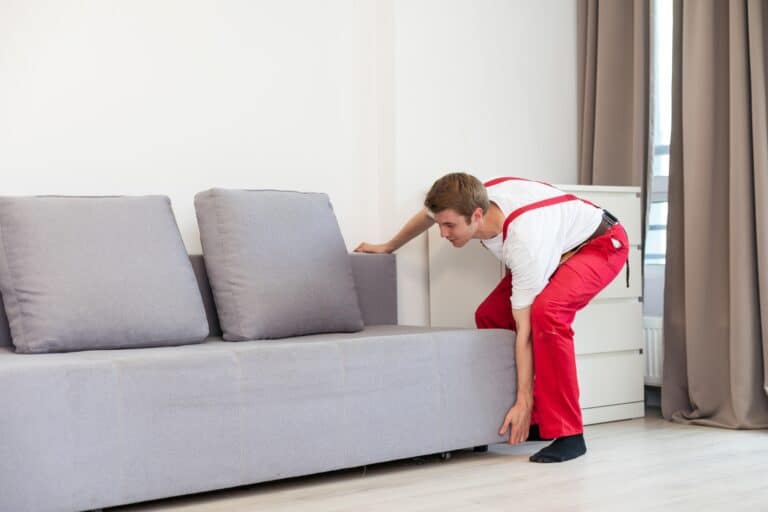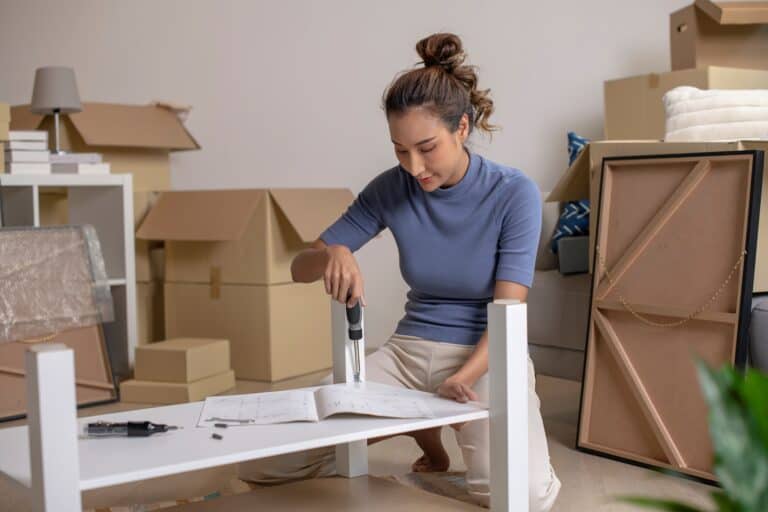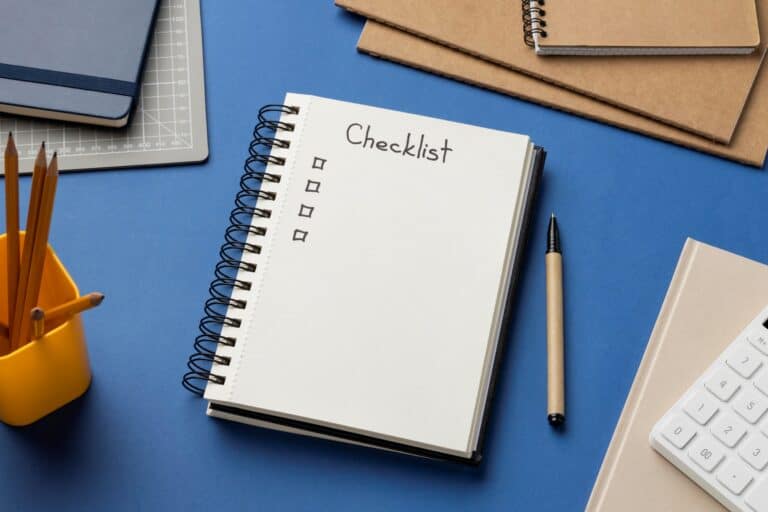How to settle into a new home after moving? Transitioning to a new home can be both exciting and overwhelming, but with the right approach, you can make it a smooth and enjoyable experience. Begin by organising essential tasks like unpacking, updating your address, and checking safety features to ensure a safe environment. This comprehensive guide offers practical steps and moving tips to help you settle into your new surroundings and feel at home quickly.
Key Takeaways
- Prioritise day-one essentials like cleaning, organising, and ensuring safety features to set a smooth transition into your new home.
- Establish routines and sort out utilities in your first week to create a sense of comfort and stability in your new environment.
- Engage with your new community by exploring local amenities, meeting neighbours, and joining clubs to make your new place feel like home.
Day One Essentials
The first day in your new home is all about setting the stage for a smooth transition. Prioritising certain tasks can make a world of difference. One of the first things to do is to organise your belongings effectively.
Creating an essentials box with necessary items like toiletries, basic kitchenware, and a change of clothes can ease the transition during those first hours. Cleaning the rooms before unpacking helps set a fresh atmosphere for your new home.
Review and Install Safety Features
Safety should be your top priority. Check smoke detectors, carbon monoxide detectors, fire extinguishers, the circuit breaker, and water shut-off valves upon moving in. This provides immediate security and peace of mind. Regular maintenance of these devices ensures long-term home safety.
Childproof your home by installing safety gates and childproof latches on cabinets to create a safe environment for young children. This prevents their access to hazardous areas and items, ensuring a safer living space for your family.
Change Locks
Securing your new home starts with changing the locks. This step prevents access by previous owners or others with a key. Change all exterior door locks immediately and consider windows and garage doors as well. This enhances your home’s security.
Unpack Essential Items
On your first night, focus on unpacking essential items that will make you comfortable. Start with the bedroom, kitchen, and bathroom. In the kitchen, prioritise items like a coffee maker, utensils, and plates. Keeping these essentials in one box streamlines the unpacking process and ensures immediate access to necessary items.
RECOMMENDATION
Start your first day in your new home stress-free by preparing an essentials box with toiletries, basic kitchen items, and a change of clothes, and clean key rooms before unpacking for a fresh start. Prioritise safety by checking detectors, changing locks, and childproofing if needed, to create a secure and welcoming environment.
Week One Tasks
Once you’ve handled the essentials on day one, it’s time to settle into a routine during the first week. This period is crucial for creating a sense of order and comfort in your new home. Take a systematic approach to unpacking and organising your space to make the process less overwhelming. Dispose of packing materials immediately to maintain a clean and organised environment.
Sort Out Utilities
In the first week, sort out utilities by taking meter readings for gas and electricity and notifying your service providers (internet, phone, cable, water, gas, electricity). If unsure about your energy supplier, contact the meter helpline.
Setting up a new tariff can help you avoid higher standard rates and save money on your utility bills. By choosing a plan that suits your needs, you ensure that your energy usage remains cost-effective while settling into your new home.
Update Your Address
Update your new address by visiting the post office and using Royal Mail’s redirection service to ensure you receive all mail. Notify your bank, building society, financial institutions, employer, and children’s schools. In addition, remember to inform other important contacts, such as your insurance providers, healthcare services, and any subscription services you use.
Updating your address with these entities ensures seamless communication and prevents any disruptions in services. It’s also a good idea to update your address on online shopping platforms to avoid delivery mishaps. By being thorough in this process, you can settle into your new home without worrying about missing important correspondence or services.
Establish Routines
A regular routine helps you settle in quickly. Create a daily schedule with regular activities to provide stability and comfort. This is especially important for children, as it helps them adapt to the new environment through familiar routines. By maintaining consistency, children can feel more secure and comfortable, which aids in their emotional adjustment to the new surroundings.
Obtain Home Insurance
Get home insurance to protect your new home and belongings from unforeseen events. Consider factors like your home’s value and the type of coverage needed. Compare quotes from multiple insurance companies to find the best coverage at a competitive price.
Making Your House Feel Like Home
Making your new house feel like home is both a physical and emotional process. Start by cleaning your home thoroughly to get rid of any dirt and negative energy left by previous occupants. This fresh start sets a welcoming tone for your new space. Incorporating personal items and thoughtful furniture layouts can significantly enhance the warmth and comfort of your home.
Clean Thoroughly
Thorough cleaning before unpacking prevents the inconvenience of moving furniture later to clean dirty spots. Start by wiping down surfaces with a solution of water and essential oils, which not only cleans but also imparts a fresh, pleasant scent to your new home. Pay special attention to corners and less visible areas to ensure every part of your new space feels fresh and inviting. This initial cleaning sets a welcoming tone and helps you begin personalising your new home with a clean slate.
Begin Decorating

Start decorating soon to make the space your own. Plan the arrangement of furniture and personal items like artwork and photos to create an inviting environment that reflects your personality. This not only makes the space feel more like home but also helps avoid future adjustments that can disrupt your comfort. By thoughtfully incorporating your favourite items and arranging furniture to maximise space, you’ll enhance the overall warmth and appeal of your new home.
Explore Local Amenities
Explore local amenities like grocery stores, parks, and essential services to feel more connected to your neighbourhood. Familiarising yourself with these places not only simplifies daily tasks but also helps you integrate into your community more smoothly. Make it a point to visit local attractions and attend nearby events to immerse yourself in the local culture. This proactive approach will help you form connections and make your new house feel like home.
Involving Family and Pets
Moving is a family affair, and involving everyone can make the transition smoother. Establishing regular family routines provides structure and helps everyone feel more settled. This is important for mental and emotional well-being, as moving to a new home can sometimes induce feelings of depression due to the significant changes.
Help children adjust by setting up their room first and involving them in unpacking their favourite items, such as toys and books, which can provide comfort and familiarity. Establishing a consistent routine is crucial, as it aids in their emotional adjustment and provides a sense of security in the new environment. Encourage them to personalise their space with decorations or posters, making it feel like their special haven in the new house.
Set up a quiet space with your pet’s bed, toys, and food to help them settle in comfortably. Keeping them in one room during the initial moving process prevents them from getting lost or stressed, providing them with a safe environment to adjust. Gradually introduce them to other areas of the house to make the transition smoother and help them feel more at home in their new surroundings.
Getting to Know Your New Neighbourhood
To feel at home, get to know your new neighbourhood. A housewarming party is a great way to meet new neighbours and start building a community. Exploring your neighbourhood on foot offers valuable insights and reduces stress during the settling-in process.
Introduce yourself to neighbours and engage in small talk to gather local insights and recommendations, setting the stage for friendly relationships and a stronger connection to the area. Join local clubs and events to make new friends and integrate into the community. Websites like Meetup can help you find interest-based groups for building a social network.

Map Out the Surrounding Area
Identify key places like the nearest hospital, bank branches, grocery stores, and other financial institutions to ease your transition into the new area. Exploring these locations helps you better integrate into your new community. In addition, take the time to locate essential services such as pharmacies, post offices, and local schools, which can be crucial for day-to-day living.
Understanding the layout of the local public transportation system can also be beneficial, making it easier to navigate your new environment and reducing the stress of commuting. By familiarising yourself with these key places, you can quickly settle into your new surroundings and start building a sense of belonging in your new neighbourhood.
Final Touches
Adding final touches to your new home can significantly enhance its comfort and aesthetic appeal. Incorporate elements like plants and low-level lighting to create a relaxing atmosphere that invites tranquillity. Make it a priority to finish unpacking within three weeks to avoid clutter and chaos. Focus on one box at a time, prioritising essential rooms such as the kitchen and bedroom, to streamline the process and establish order.
Once the unpacking is complete, take time to relax and enjoy your new home. Allocate moments to settle into your new environment and appreciate the changes. This not only aids in mental relaxation but also helps you feel more settled and at ease in your new surroundings.
Summary
Settling into a new home after moving can be a transformative experience filled with excitement and challenges. By following these comprehensive tips, you can ensure a smoother transition and make your new house feel like home quickly. Prioritise essential tasks such as unpacking, updating your address, and securing your home to create a safe and welcoming environment. Embrace your new surroundings by exploring local amenities and engaging with your community through local clubs and events.
Establishing routines and personalising your space will help you and your family adjust more comfortably to your new environment. Remember, settling in takes time, so be patient and enjoy the journey of making your new place a true home. With these strategies, you’ll soon find yourself feeling settled and at ease in your new neighbourhood.
Frequently Asked Questions
What should be the first thing I do after moving into my new home?
The first thing you should do after moving in is check all safety features, like smoke detectors, and change the locks for peace of mind. Safety should always come first in your new space!
How can I make my new house feel like home quickly?
To make your new house feel like home quickly, focus on cleaning thoroughly, adding personal decorations, and exploring your local area. These steps help create a warm and inviting atmosphere.
How do I help my children adjust to the new home?
To help your children adjust to the new home, set up their room first and involve them in unpacking their favourite items. Establishing a consistent routine can also provide the emotional stability they need during this transition.
What are some important tasks to complete in the first week?
In your first week, make sure to sort out utilities, update your address, and establish routines to create a sense of order and comfort in your new home. These tasks will help you settle in smoothly.
How do I ensure my new home is safe and secure?
To keep your new home safe and secure, regularly test smoke detector batteries, know where your circuit breaker and water shutoff valve are, and reprogram your garage door codes. Don’t forget to childproof your space and get home insurance for extra peace of mind!







